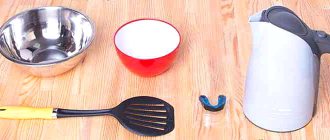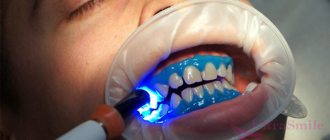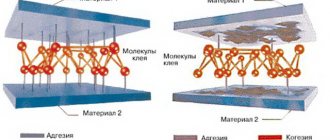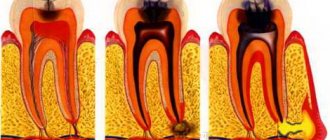Date of publication: 09/28/2018
Tooth filing has been used in dentistry since the 19th century. At that time, the procedure helped treat caries by mechanically removing damaged tissue. Today the technique is used to eliminate other problems, mainly aesthetic ones.
For example, teeth can be filed if one or more units stand out from the general row due to their increased length. Filing can also help with small chips on the edges of the tooth.
In what cases is tooth filing used?
There are different opinions about the advisability of the procedure. It is mainly carried out in the following cases:
- When the upper incisors or canines stand out too much. This not only disrupts aesthetics, but can also interfere with proper bite. In this state of affairs, the teeth can be shortened a little so that they fit better into the dentition.
- If there are small chips on the edges of the teeth. A slight grinding of the enamel will help smooth out the edge.
- If there are sharp corners. Sometimes, due to anatomical features, the front teeth may have protruding parts. They may not look aesthetically pleasing or even damage the cheek.
- For orthodontic bite correction. Sometimes teeth are filed down on the sides to make it easier to move them into the correct position. This is important when installing braces if your teeth are very crowded.
- Filing down the front of the teeth is used when installing veneers. The teeth are also ground down before crowns are installed.
The advisability of filing is determined individually only at the appointment of a specialist.
Causes of tooth abrasion
Natural processes such as swallowing and chewing are major and minor causes of wear and tear on tooth enamel. As a rule, we cannot reduce the impact of these phenomena on the appearance of teeth, but we rarely have to worry about this. Natural wear of teeth is practically invisible and becomes noticeable closer to old age.
On the contrary, pathological causes of wear, such as bruxism, teeth clenching, or malocclusion, may require complex treatment from a specialist. In rare cases, tooth wear is the result of hazardous work.
Signs and manifestations
The most obvious sign of enamel wear is deformation of the visible part of the tooth. However, there are other, less noticeable, but no less unpleasant forms of manifestation of pathology. These include:
- reduction of the gap between the root canals;
- pulpitis;
- change in facial contours, height of occlusion;
- increased sensitivity of teeth;
- injury to oral tissues from sharp edges of teeth that have been destroyed;
- overload of the masticatory muscles.
When to see a doctor?
It is a mistake to believe that tooth abrasion must be treated after the onset of external jaw deformation or when increased sensitivity is detected. It is very important to consult a dentist in the early stages of the disease if you notice the habit of clenching your teeth during periods of constant stress. At this stage, it is possible to conduct a comprehensive examination and identify the presence and exact cause of the emerging pathology.
At first, you can get by with protective mouth guards. In advanced cases, prosthetics are required in conjunction with comprehensive treatment of the teeth and oral cavity. In some cases, the bite is also corrected using braces. It is important to remember that severe tooth deformations significantly complicate and, by the way, increase the cost of the restoration process.
Features of treatment at different stages
When diagnosing minor damage, a specialist may prescribe:
- remineralizing therapy;
- deep-acting fluoridation;
- grinding to correct occlusion.
In case of severe malocclusion or tooth deformation, prosthetics are performed. On an individual basis, global correction of jaw closure may be required. This procedure is performed after completing the following procedures:
- TRG (skull image);
- modeling of the ideal occlusal plane;
- building the Spee and Wilson curve;
- recreation of dynamic elements of occlusion (including the use of articulators and facial bows, wax modeling of the jaw).
It is especially important not only to perform all procedures in a timely manner, but also to perform efficiently, from examination to treatment. Properly carried out activities are the key to good health and a beautiful smile.
Expert opinion
Roman Borisovich Alekperov
orthopedic dentist
Experience: 24 years
If there are indications for filing teeth, it is important to entrust this procedure to an experienced dentist who will correct the aesthetic defect and not cause harm to the teeth. Self-filing is impossible and extremely dangerous - you can seriously damage the tooth, and in the future you will have to resort to microprosthetics or crown prosthetics. There is also a high risk of injury to the mucous membrane and infection.
General principles of grinding teeth for crowns
Preparing teeth for metal-ceramic crowns has some peculiarities. Thus, it is necessary to grind off a significant amount of enamel and dentin (up to 2 mm), which requires local anesthesia, especially when preparing vital (living) teeth. Sometimes it is necessary to first remove the pulp with careful treatment and fill the root canals , especially if it has been destroyed by a carious process.
Preparation begins with the separation of contact surfaces. For this purpose, special diamond discs or heads are used, which avoids injury to the hard tissues of neighboring teeth. Next, a ledge is outlined at the gum level. The shoulder width for metal-ceramic crowns is 1 -1.5 mm. Marking grooves can then be created on the vestibular and oral surfaces. Their depth corresponds to the layer of hard tissue that needs to be sanded off (1.5-2 mm). A supragingival ledge is formed in the cervical area. Having removed a sufficient amount of tissue, the clinical crown by grinding down the hard tissue on the chewing surface.
Next, a ledge is formed by first installing a retraction thread soaked in a special liquid into the gingival sulcus. This is necessary to protect the marginal gingiva from injury from the sharp bur. The tooth preparation is completed by smoothing out sharp edges and corners and giving the stump a smooth outline. In this way, a sufficient amount of space is created for a single crown without grinding adjacent teeth , the enamel of which is not damaged. There are also designs for which it is not necessary to prepare hard tissues.
How is filing done?
The technology varies depending on the purpose for which the procedure is performed. The process includes a number of steps:
- - Diagnostics. The doctor determines which teeth will be filed and for what purpose. To do this, a visual inspection is carried out, the cause is studied, and the method of performing the procedure is determined.
- — The area in which manipulation is necessary is determined. For this, carbon paper, wax plates, and special aerosols can be used. This helps to highlight or color an area that, for example, prevents the jaws from closing properly. In difficult cases, a plaster model of the jaw can be made.
- If the procedure requires significant removal of hard tissue, anesthesia is performed.
- Sawing is done using a diamond bur. On chewing teeth, a small layer of enamel on the protruding tubercles can be filed away. If we are talking about incisors, the movements are multidirectional and depend on the situation.
- After the procedure, the surface that was manipulated is polished. Also, remineralizing substances can be applied to the surface of the teeth, as well as compositions to strengthen the surface and reduce sensitivity.
When filing teeth, the thickness of the enamel in the treated areas changes. This may cause increased sensitivity. Usually this is a temporary phenomenon and in the first days it is necessary to refrain from eating hot and cold foods so as not to provoke discomfort and pain. If the problem does not go away over time, you should consult a doctor.
Treatment of tooth wear
The main task of medical intervention is to establish and eliminate the cause of the pathology. Treatment methods largely depend on this. They include stabilization of the patient’s general condition in case of endocrine and other disorders, change of place of work if we are talking about hazardous work.
In cases where the enamel on the teeth has worn off, use:
- Medication methods
These are gels, solutions, toothpastes that reduce hypersensitivity and saturate the enamel with minerals.
- Restoration methods
Restoration of teeth using composite materials (direct restoration). This technique has proven itself well on the front teeth, but is less effective on the chewing teeth.
- Orthopedic treatment
is added if the problem affects dentin.
Teeth are restored using inlays, crowns, fixed and removable dentures. The main condition for prosthetics is the use of cast crowns. Stamped ones, especially on chewing teeth, fail very quickly. The cladding is used plastic or ceramic. Recently, restoration with veneers has begun to be used.
Clasp dentures with occlusal overlays are widely used as a treatment method for increased tooth wear. The advantage of the method is that it does not require preparing the teeth (removing the pulp). Depulpation makes teeth fragile, which is already a problem with this pathology.
- Orthodontic treatment
is used for malocclusion and misalignment of teeth.
Medicinal bite plates are used. They prevent the teeth from touching to form a new bite height. For the same purpose, mouth guards are put on. Unlike plates, mouth guards can immediately separate the bite by 4 mm, which means there will be fewer intermediate stages. Mouthguards are used at 2-3 degrees of abrasion. After correcting the bite height, prosthetics are performed.
Dysfunction of the temporomandibular joint begins to be treated by restoring the height of the bite. Upon completion, signs of dysfunction disappear in most patients. Then special, inclined plane mouth guards are used to return the lower teeth and jaw to their physiological position.
- Surgery
As a result of the operation, the dentist lengthens the crown part of the tooth by removing the bone tissue of the alveolar process.
Online consultation with a doctor
If you are interested in questions about teeth filing, you have been prescribed this procedure, but have doubts about its necessity, or are simply concerned about the condition of your teeth, then it is best to undergo an examination and get advice from a dentist. Under no circumstances should you do the filing yourself. A specialist will assess your dental health, listen to complaints and give professional recommendations. Without a competent opinion, you can complicate the situation, which will lead to illness or already have hidden illnesses. Treatment will be more expensive and, in some cases, longer. At the consultation, the vector of your next actions will be set and doubts will be dispelled.
Restoration of worn teeth
Restorative treatment is carried out while preserving at least half of the hard tissues of the tooth. The technique takes place in several stages:
- Preparation. Necessary to identify the causes of diseases and their elimination or minimization, as well as the protection of remaining teeth. During preparation, an occlusal splint is made and installed if the patient suffers from bruxism. If necessary, the doctor prescribes consultations with various specialists, explains the rules of oral hygiene, and sanitizes foci of infection.
- Evaluation of the preparatory stage. After some time, the patient comes for an appointment, and the doctor assesses the condition of the teeth, checks whether the patient followed all the recommendations correctly, and discusses the upcoming treatment with him.
- Restoration. It is carried out in a certain order. First, the teeth are prepared, then the teeth on the upper jaw are restored, and only then on the lower jaw. Using a table of anthropometric data for each tooth, the doctor gives the patient's new teeth a certain length and shape.
- Observation. After successful treatment, the doctor observes the result for some time. In the first year, the patient should come for an appointment once a month, then less and less, but not less than once every 12 months. If any defects are identified, they are repaired or other treatment methods are applied.
This type of treatment, like any other, requires the patient to strictly adhere to all recommendations, give up bad habits, eat right, regular examinations by a specialist, and carefully observe hygiene skills.
What is teeth separation: which doctor does it?
Separation is a technique for expanding the interdental space, during which a thin layer of enamel (no more than 0.25 mm) is removed from the sides of the incisors, thereby freeing up space. Sawing is carried out using a drill, strips, and sometimes a special file is used. Carefully remove the protruding part where the two teeth meet. The procedure is a worthy alternative to extirpation, it allows you to keep your teeth healthy and functional, and
avoids the removal of molars (6, 7 and 8) and other dental units.
Separation of enamel is safe for teeth and does not provoke their hypersensitivity.
Contraindications
Any dental procedures have contraindications. Separation is not carried out when:
- caries;
- pulpitis;
- periodontal inflammation;
- excessive bleeding and sensitivity of the gums.
Also, any infectious diseases of the oral cavity are contraindications to interproximal enamel reduction. Carrying out surgery in the presence of contraindications threatens the spread of infection to healthy teeth and tissues in the oral cavity.
What and how it is performed on the front upper and lower incisors
Mechanical separation on incisors is performed in one visit to the dentist:
- Using a saw and a drill with a diamond disc (special tip), the side sections of the enamel are removed in an even layer. To prevent injury, the mirror pushes back soft tissue. The file is used less frequently than the vertical attachment of drills, but provides higher accuracy.
- Sawed surfaces are ground and polished. Sanding smoothes out unevenness.
- To protect teeth from hyperesthesia, a strengthening composition is applied to the enamel.
Immediately after the operation, you can see the result - an increase in the space between the incisors. Physiological separation differs in many ways from mechanical separation and takes longer:
- Wedges are inserted into the interdental spaces or they are stretched with rubber bands.
- The patient is sent home for a certain time.
- The wedges are removed and further therapeutic manipulations are carried out.
After the procedure, if it is necessary to correct the bite, an elastic chain is placed on the dentition to close the gaps. They are tightened due to the alignment of the bite over one to four months.
Advantages
The main advantage of the procedure is the ability to preserve healthy teeth. Additional benefits:
- painlessly and quickly frees up space for orthodontic therapy (correction of crowding or malocclusion, jaw prosthetics);
- no long recovery required;
- soft gum tissue is not damaged;
- there is no need for additional treatment of gums (only in the absence of complications);
- the integrity and sensitivity of the teeth is not impaired;
- The operation is performed in one session lasting up to 40 minutes.
Interproximal enamel reduction is only safe when performed by a qualified, experienced dentist. Therefore, you need to carefully choose a clinic and specialist.
Who is indicated for the procedure?
Enamel separation is prescribed in cases where the teeth are healthy and there is no indication for their removal, but the row is too dense, which makes it impossible to carry out orthodontic treatment to correct the bite. Main indications:
- the width of the upper incisors does not correspond to the width of the lower ones;
- protrusion of the upper and lower frontal incisors;
- removal is contraindicated if the bite is misaligned;
- asymmetry or inclination of the teeth of the upper and lower rows;
- correction of triangular teeth, due to the shape of which, after correcting the bite, black small triangles remain between the incisors.
It makes sense to carry out separation before and during wearing orthodontic structures (braces, plates). Mandatory before prosthetics (installation of a crown, bridge), will help with tooth retention (growth retardation). The main goal of the procedure is to correct the shape/size of the tooth and at the same time increase the free space for it to move into the correct position.
Indications
Among dental specialists, there are opposing views on the procedure for filing teeth. Some consider it harmful to health and impractical, while others, on the contrary, recommend it to their patients as an effective method. However, there are situations when this is necessary.
Installation of crowns
To firmly fix the elements in the oral cavity, they must be tightly adjacent to the teeth. Since the natural shape of molars or incisors is rarely ideal, filing of the superficial hard tissues is necessary. This is what helps the tooth in the future to obtain the desired shape, thanks to which the prepared crown is tightly attached and does not get knocked out among the other units.
Attaching veneers
Ceramic plates, which are fixed on the surface of natural teeth, are significantly thick. In order to install them firmly and align with existing elements, a small amount of enamel is removed from the vestibular part of the jaw row.
Preparation for inlays
If it is necessary to hide cavities caused by caries, dental specialists can use ceramic or metal inlays. To secure them to the tooth, they require side walls and a certain depth near the cavity.
Installation of orthodontic structure
Grinding down the top layer of teeth helps create space for adjusting the position of other row units without having to remove them. This option is also suitable if the teeth are too close to each other. The procedure makes it easier to install braces.
Damage to tooth enamel
Chips on the incisors can be hidden by slightly sawing off the top cover. This will add aesthetics to your smile and eliminate the need for restoration.
Elongated incisors
When the front teeth are longer than the other units in the oral cavity, this not only brings psychological discomfort to the person, but can also create problems with diction. It also interferes with the main function of teeth – chewing food. In this case, alignment of the protruding parts is essential.
Sharp corners
The anatomical shape of a tooth is rarely ideal. Sharp corners are most often recommended for filing to create a neat appearance of the oral cavity.











